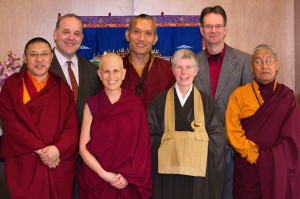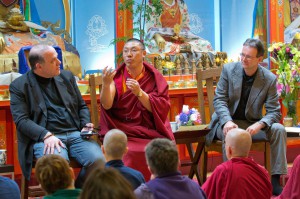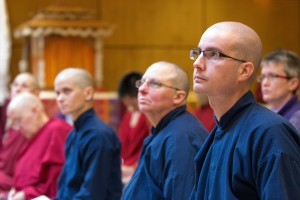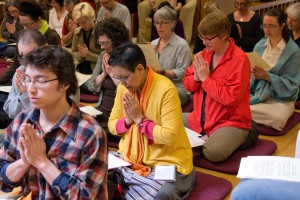Sharing Heart Sutra Wisdom in Many Traditions
Written by: Leigh Miller Sangster

Heart Sutra symposium teachers and audience engage in discussion at Maitripa College. From left to right, Roshi Jan Chozen Bays, Ven. Thubten Chodron, Lama Tsering Gyaltsen, Khenpo Karl Brunnhölzl, Khenpo Jampa Tenphel, and Yangsi Rinpoche.
Photos: Marc Sakamoto
Maitripa College in Portland, Ore., hosted “The Heart Sutra in Philosophy and Practice,” perhaps the first gathering, in the Pacific Northwest, of masters from five Mahayana lineages to consider the famous text.
At the April 14 and 15 event, teachers from the four major Tibetan traditions, from Zen, and from Western academia, presented philosophical understandings of the Heart Sutra. The teachers led recitations of the text with distinctive and varied melodies and translations, and guided meditations on essential points.
Venerable Thubten Chodron, founder and abbess of Sravasti Abbey, which is north of Spokane, Wash., said the text describes the bodhisattva stages of the path.

Heart Sutra in Philosophy and Practice” symposium speakers. Front row, L to R: Khenpo Jampha Tenphel, Venerable Thubten Chodron, Roshi Jan Chozen Bays, Lama Tsering Gyaltsen Rinpoche. Back row, L to R: Dr. James Blumenthal, Yangsi Rinpoche, Khenpo Karl Brunnhölzl.
The Heart Sutra begins with a “great community of monks and bodhisattvas” surrounding the Buddha at Vulture Peak in India. The Buddha is in a profound state of meditation, “absorbed in the concentration on the categories of phenomena,”1 while the bodhisattva Avalokiteshvara is “looking perfectly at the practice of the profound perfection of wisdom, perfectly looking at the emptiness of inherent existence of the five aggregates.”2
The disciple Shariputra asks Avalokiteshvara, “How should a child of the lineage train who wishes to engage in the practice of the profound perfections of wisdom?” Avalokiteshvara’s answer to Shariputra comprises the bulk of the sutra.
Khenpo Karl Brunnhölzl, from Nalandabodhi in Seattle, said Avalokiteshvara’s answer describes what happens in the mind of a Bodhisattva meditating on emptiness. Furthermore Avalokiteshvara, the embodiment of the compassion of the Buddhas, as speaker also shows that it is “compassion itself who gives emptiness a voice.”
Dr. James Blumenthal, professor at Maitripa College and Oregon State University, noted that the Heart Sutra is one of the few instances in which an enlightened disciple of the Buddha, rather than the Buddha himself, is the speaker of a sutra. This raises interesting questions in Buddhist studies about the transmission of spiritual authority, and the social and historical contexts out of which the Heart Sutra, and Mahayana Buddhism, emerged.

Speakers (L to R) Dr. James Blumenthal, Khenpo Jampa Tenphel Rinpoche, and Karl Brunnhölzl discuss a question from the audience at Maitripa College.
Avalokiteshvara tells Shariputra practitioners should “correctly and repeatedly behold those five aggregates as empty of inherent nature.” Here is a link to one version of the Heart Sutra.
Brunnhölzl said there are 36 “Nos” in the text denying the inherent nature of things, a repetition that defies our rational, dualistic mind.
Brunnhölzl said, “The ultimate is inexpressible, but not inaccessible.” The ultimate is accessed, the Heart Sutra shows us, by wielding with great compassion a “sword of wisdom that is double edged, cutting away both subject and object.”
Venerable Chodron pointed out that the repetitive negations are instructions to keep cutting away what doesn’t inherently exist, until we are left with nothing. However, emptiness is not just negation of samsaric things, she said, but emptiness too does not inherently exist.
We feel, “because we are humans and we want to hang on to something, that ‘ultimate nature’ must really be there,” she said, adding that this is a common misinterpretation. The Heart Sutra says there is nothing to hold on to, Chodron said, adding that with nothing to cling to there is nothing to protect, assert or defend.
The speakers all addressed what happens then to our very dear and cherished sense of self, which it is terrifying to imagine not protecting, asserting, and defending. Roshi Jan Chozen Bays, co-abbot of Great Vow Zen Monastery in Clatskanie, Ore., asked, “What is the glue holding our sense of self together, and why does the mind not want to stay in the present moment?”

Monastics from Sravasti Abbey attending the Heart Sutra symposium at Maitripa College.
Brunnhölzl said, “The Heart Sutra takes away all our ‘toys’- first the aggregates, then our Buddhist toys, then our favorite toy, the ego – so what is the mind without ‘me’?”
Lama Tsering Gyaltsen Rinpoche, from Saraha Nyingma Center of Eugene, said that everything we see and experience is a manifestation of our minds.
Brunnhölzl added, “It is a relief to shed the burden of sustaining ego existence,” echoing other teachers’ suggestion that letting go of ego leads to fearlessness, humor, and freedom.
After all the negations, when the disciple likely feels on very shaky ground, the Heart Sutra continues, “With nothing to attain, a bodhisattva relies on Prajnaparamita (perfection of wisdom), and thus the mind is without hindrance…there is no fear.”3
Bays said prajna is wisdom that, unlike knowledge to be accumulated, is always available in equal measure to each being as their “birthright.” One shifts from trusting one’s own limited mind to trusting prajnaparamita, by which suffering is relieved and our potential is unfettered.
Khenpo Jampa Tenphel, from Sakya Monastery of Seattle, extolled the prajnaparamita vehicle as of quintessential importance to practitioners of any philosophical orientation, and encouraged our continued study of this “vast and deep” sutra.

Participants recite the Heart Sutra at Maitripa College during the symposium.
In discussion of various Mahayana approaches to contemplating emptiness, all agreed that “heart” really means “essence” of Buddha’s teaching in Tibetan and Japanese languages. Finally, in the enlightened mind, there is no “Zen,” “Geluk,” “Nyingma,” “Kagyu” or “Sakya” emptiness.
Yangsi Rinpoche closed the weekend with a final recitation of the Heart Sutra, because it “purifies hindrances and obscurations that may arise in study and practice, and generates the wish for all beings to generate wisdom and compassion.”
Reciting the text together, as Buddhists across Asia have done for centuries, gives another way to access its meaning. Six versions of the text, used by the teachers in their lineages, had been prepared for attendees’ use so they could take the versions home for continued study and practice.
Yangsi Rinpoche said afterwards, “The main interest in organizing the symposium was to bring together teachers in the Mahayana Buddhist tradition to meditate and make offering of practice to all of our teachers, and also to start the ultimate form of knowledge sharing, which is with each other. And from the beginning Maitripa College wanted to include dharma associations in Portland, but not all were able to participate this time, but we want to pursue this type of symposium further in the Northwest area.”
The gathering yielded great richness and meaning, with speakers including Western academics, Western-born monastics, and Tibetans trained in the monastic scholarship of Tibetan communities, concluded Dr. Steven Vannoy, a professor of psychology at Maitripa College and the University of Washington.
The Heart Sutra ends with the Buddha arising from meditation to affirm Avalokiteshvara’s discourse, adding that “Even the tathagatas rejoice.” Those gathered at Maitripa College were overjoyed, like the community at Vulture Peak, and dedicated the merit to the long lives of our teachers and the enlightenment of all sentient beings.
1. The Heart of the Perfection of Wisdom Sutra, translated from the Tibetan by George Churinoff. FPMT Education Services.
2. From Sravasti Abbey’s version of the sutra.
3. From Great Vow Zen Monastery’s version of the sutra.
